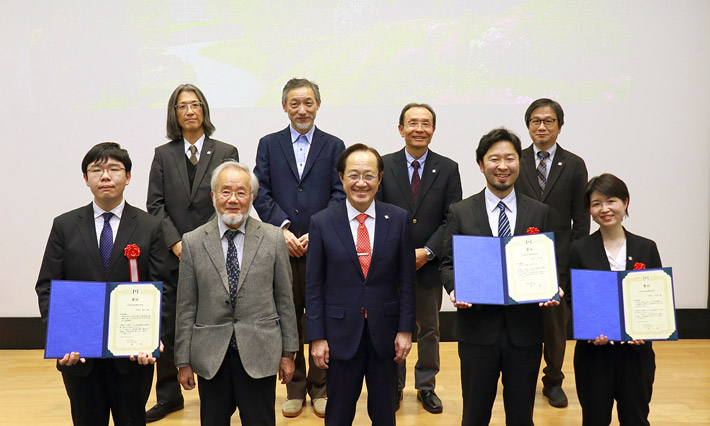Three researchers received the 2023 Yoshinori Ohsumi Award for Fundamental Research, financial support from Tokyo Tech for researchers under the age of 40 engaged in fundamental research. The award ceremony was held on January 24, 2024.

Front row from left: Assistant Professor Yuta Amezawa, Honorary Professor Yoshinori Ohsumi, President Kazuya Masu, Assistant Professor Kei Tanaka, Associate Professor Mai Sawada
Yoshinori Ohsumi Award for Fundamental Research is designed to provide research funds for exceptionally talented young researchers engaged in fundamental research that requires a long-term perspective. Three researchers were awarded as FY 2023, the 6th award counting from its predecessor "Yoshinori Ohsumi Fund for Fundamental Research".
During the ceremony, President Kazuya Masu explained Tokyo Tech's support initiatives for fundamental research to the award winners, and Honorary Professor and 2016 Nobel laureate in Physiology or Medicine Yoshinori Ohsumi delivered a congratulatory speech. The award winners, President Masu, screening panel members including Executive Vice President for Research Osamu Watanabe, and Honorary Professor Yoshinori Ohsumi later enjoyed conversation during which they actively exchanged opinions regarding topics such as current research themes of the award winners.

Three awardees and two presenters talking at the ceremony
This award has been renamed as the "Yoshinori Ohsumi Award for Fundamental Research" to provides even broader support starting in 2023.
FY2023 Award Winners
Study of the crustal fluid distribution based on systematic waveform classification and seismic wave propagation analysis of seismic later phases
Fluids such as water or gas exist not only on the surface of the earth but also in its interior. Fluids in the earth's crust (crustal fluids) affect seismic activity. Therefore, understanding the spatiotemporal change in crustal fluids with a high resolution of several kilometers and several hours is important. However, it is difficult with conventional methods. In this study, we focus on the changes in the waveform shape of "later phases," which are generated when seismic waves are reflected or scattered by the crustal fluid. Later phases are particularly sensitive to their origin therefore they are useful for detection of the spatiotemporal change in crustal fluids. Our target in this study is later phases observed around the Moriyoshi volcano in Akita, northeastern Japan. Temporal changes in the later phase shapes with several patterns have been reported in this area. The movement of crustal fluid at the later phase origin was pointed out as the main factor of the change in the later phase shape. To reveal the spatiotemporal change in the crustal fluid as the later phase origin in this area, in this study, we classify the waveform patterns of later phases and calculate the waveforms corresponding to each later phase pattern using seismic wave propagation simulations.
How to Form the Most Massive Stars
Among the stars that light up the night sky, there are 'very massive stars' with more than 100 times the mass of the sun. The intense ultraviolet radiation emitted by these very massive stars has long been thought to blow away the surrounding gas, making it a mystery how they could acquire such a vast mass. However, recent studies have shown that 'disk accretion' is a key factor in this process. In this process, a high-density gas disk diverts ultraviolet radiation in the upward and downward directions of the disk, while simultaneously supplying a large amount of gas to the central star. In our research, we use advanced numerical simulations that consider physical processes such as magnetic fields, radiation, and dust particles to analyze the dynamics of disk accretion and ultraviolet feedback. Furthermore, by collaborating with an international observation project using the ALMA telescope, we aim to validate the birth of very massive stars through disk accretion.
Associate Professor Mai Sawada
Department of Civil and Environmental Engineering, School of Environment and Society
Internal stress measurements revealing soil degradation mechanisms induced by wet-dry cycles: the future for geotechnical structures maintenance methods
Climate change impacts are vastly observed, including the effects on shallow zones in the ground that experience drastic wetting and drying. These wet-dry cycles can induce crack formation, triggering geohazards as crack openings will promote rainfall infiltration and hence reduce soil strength. We aim to model and predict crack initiation and its early-stage effects on the deterioration of geotechnical structures. In order to develop models that can predict internal stresses accurately, a novel laboratory test will be introduced to measure internal stresses during crack initiation, detecting minor or internal cracks that are invisible from stress variations. In summary, we will look into the cracking behaviour by measuring stresses and developing stability assessment methods considering the effects of cracking. The outcomes can aid in updating maintenance techniques for geotechnical structures considering new geohazard (i.e. desiccation cracking), adjusting them to environmental and societal changes.






